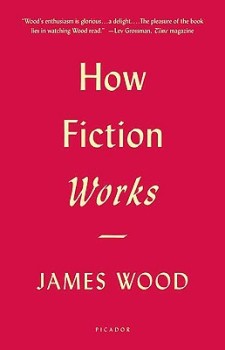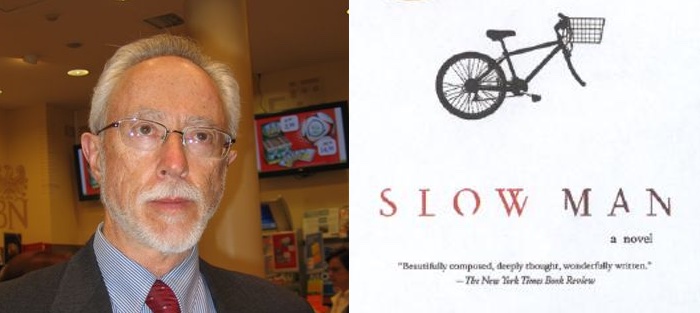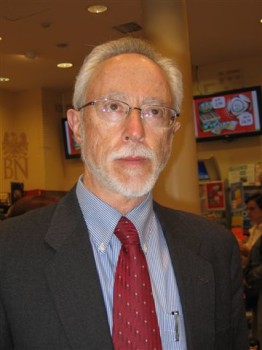Paul Rayment, the protagonist of J. M. Coetzee’s novel Slow Man (Viking, 2005), is a sixty-year-old photographer born in France and living in Australia, divorced and childless. In the first sentence of the novel a car hits him and throws him off his bike. The second sentence takes us inside Paul’s head:
Relax! he tells himself as he flies through the air (flies through the air with the greatest of ease!), and indeed he can feel his limbs go obediently slack.
The familiar phrases of discernment (he tells himself, he can feel) assure us that we are in the hands of an omniscient narrator, someone who can see Paul from the outside as well as the inside. The first word in italics is Paul’s thought in his own diction (indirect interior monologue, often called free indirect style), while the second italic section is a line from a well-known song streaming through his consciousness. The first time I read those lines wind whistled by my ears as the point of view zoomed from inside Paul out to omniscient reporting at mid-distance, then deep into stream of consciousness (the song quote). “Indeed” swept me way out and introduced me to an insightful but detached commentator with a mind of his own. “Whaddyaknow,” he seems to say, cool in the face of disaster. “Paul has obeyed his own command.” I like to imagine Mr. Coetzee laughing at the rules against authorial intrusion as he uses this voice to add depth and breadth to his novel. Finally the camera returns to mid-distant, omniscient reporting to relate what Paul feels. These lines provide a sort of map of the novel, preparing the reader for the in-and-out swooping of its point of view.
I owe this understanding of distance and point of view to David Jauss’s essay “From Long Shots to X-Rays: Distance and Point of View in Fiction,” from On Writing Fiction: Rethinking Conventional Wisdom About the Craft. Jauss sees a spectrum of possible distances between the dramatic, entirely external point of view of a play and the deeply internal one of stream of consciousness, which reproduces the process as well as the content of thought. An omniscient point of view is able to move in or out of a character’s mind at will, but typically only enters one or a few minds in a given scene or section. Thus it is largely external or dramatic. At a middle distance between dramatic and stream of consciousness is indirect interior monologue, a major mode of storytelling in most modern fiction. In this mode, the author inhabits and virtually becomes the character, thinking and speaking in the character’s persona and using his diction. This is not to ignore the conventional division of points of view into first, second and third. Slow Man uses a third-person point of view, referring to Paul as “he,” but within this point of view the narrative voice careens in and out so strikingly it almost suggests another person. Could this person be the author?
 Ever since Flaubert, according to Wayne C. Booth’s Rhetoric of Fiction, writers and critics have been trying to “drive the author from the house of fiction,” forbidding philosophical ruminations and other commentary. But this effort has failed. Booth finds the author inevitably present “when he moves into or out of a character’s mind.” Seeing through the eyes of a single character can be an effective means for rendering the inner life, but it has limitations, as Richard Russo points out in his essay “In Defense of Omniscience.” Among these are difficulty in communicating information to which characters may not have access; inability to express attitude toward characters, actions and events; difficulty moving from one character’s mind to another; inability to travel in space and time; and curbs on freedom of voice and diction. Today omniscience may seem to belong to 19-century novels, with their typical direct address to “dear reader,” but Russo asks, “Who says authors shouldn’t intrude into fiction?”
Ever since Flaubert, according to Wayne C. Booth’s Rhetoric of Fiction, writers and critics have been trying to “drive the author from the house of fiction,” forbidding philosophical ruminations and other commentary. But this effort has failed. Booth finds the author inevitably present “when he moves into or out of a character’s mind.” Seeing through the eyes of a single character can be an effective means for rendering the inner life, but it has limitations, as Richard Russo points out in his essay “In Defense of Omniscience.” Among these are difficulty in communicating information to which characters may not have access; inability to express attitude toward characters, actions and events; difficulty moving from one character’s mind to another; inability to travel in space and time; and curbs on freedom of voice and diction. Today omniscience may seem to belong to 19-century novels, with their typical direct address to “dear reader,” but Russo asks, “Who says authors shouldn’t intrude into fiction?”
In How Fiction Works, James Wood says, “A gap opens between author and character, and the bridge . . . between them simultaneously closes that gap and draws attention to the distance.” Wood shows how gaps between author and character persist to fiction’s advantage, and he discusses their range of size. Small and subtle can give us the ducks in Robert McCloskey’s Make Way for Ducklings when they encounter a swan boat and offer a polite greeting. “The big bird was too proud to answer,” says the author, letting us experience the ironic juxtaposition of the duck’s view that the boat is a live bird and the author’s (and our) superior knowledge.
Slow Man continues:
Like a cat, he tells himself: roll, then spring to your feet, ready for what comes next. The unusual word limber or limbre is on the horizon too.
Who but the author would observe, at this semi-conscious moment in Paul’s life, that a word was “unusual”? Or consider alternate spellings? Clearly the author intends to make his presence known to us. His distant, narrative voice could almost be saying, “Mind the gap,” each time it enters the story.
Paul passes in and out of consciousness and then awakes in the hospital, confused and frightened.
‘What is this?’ he mouths or perhaps even shouts, meaning What is this that is being done to me? or What is this place where I find myself? or even What is this fate that has befallen me?
Paul does not know whether his words actually reach the room, but the distant narrator is ready to step in and interpret his meaning. The duet between extremely close, immediate third-person narration and interpretation by a distant narrator continues:
Is it serious?: if there is time for only one question, then that is what the question ought to be, though what the word serious might mean he prefers not to dwell on.
Soon a social worker comes to arrange nursing care for Paul at home. Pulling still farther back, the author comments, “the rules of the game make it hard for either of them to be straight.” The social worker assigns an obnoxious young nurse to Paul. He accepts her, fearing the social worker’s power. The author corrects Paul’s view:
It is possible, of course, that [Paul] overestimates Mrs. Putts’ concern. When it comes to welfare, when it comes to care and the caring professions, he is almost certainly out of date.
Now the author takes the opportunity to comment on the “brave new” world of laissez faire, in whichcare has been forgotten, expressing his opinions as freely as any 19th-century writer. Speaking of the homeless, he says, “ . . .and if they wake up alive the next morning, good on them.” Accustomed as we are by now to this critical, analytic voice, we accept it as part of the story’s dream and sense no interruption. The same is true of the following authorial explication of Paul’s mood, in which the voice explores Paul’s varying distances from his own self:
This is what it means to be gloomy: at a level far below the play and flicker of the intellect (Why not this? Why not that?) he, he, the he he calls sometimes you, sometimes I, is all too ready to embrace darkness, stillness, extinction.
This passage could almost be a riff on Jauss’s idea that distance is more important to point of view than person. The narrator seems to say, “Call Paul he, I, or you—whatever you like—but look below the play and flicker of Paul’s intellect and you’ll find darkness, stillness, extinction.”
Enter the good nurse, Marijana, a married Croatian woman with whom Paul will fall inconveniently in love. Though Paul is pleased to have Marijana caring for him, his gloom extends to his body and sexuality. He despairs of appealing to a woman again and regrets especially having no children. In an elevator he chances upon a delicate, full-breasted young woman in dark glasses with her dress on inside out. Attracted to her, he fantasizes sex and becomes again depressed. The narrator pulls back to observe about his moods:
He likes to think they come from elsewhere, episodes of bad weather that cross the sky and pass on. He prefers not to think they come from inside him and are him, part of him.
An omniscient author can make himself heard through the most subtle moves towards or away from a character or can tell a highly opinionated story from a distance of many years and the space of a death, but what happens if the author walks into the story and turns up on the page? While Paul Rayment is yearning for Marijana who should turn up but Elizabeth Costello, Coetzee’s thinly disguised alter ego as well as principal character of an eponymous novel, published two years before Slow Man. She is not only an author, but also the author of the novel we are reading, and promptly recites its opening lines. She asks for Paul’s hand to assure herself that he is real and explains her presence:
‘You came to me, that is all I can say. You occurred to me—a man with a bad leg and no future and an unsuitable passion.’
To Paul’s dismay and annoyance, she insists on staying and points out the absurdity of his wish to seduce Marijana. Elizabeth proposes an alternative: a rendezvous with the young lady Paul saw in the elevator, Marianna, who turns out to be blind.
 Now that the author has become a character, she speaks in her own voice, offers her own insights and criticizes Paul’s hopeless passion. How are we to read the novel from here on? Has a realistic novel turned to fantasy, with the author springing from the page to join the cast of characters?
Now that the author has become a character, she speaks in her own voice, offers her own insights and criticizes Paul’s hopeless passion. How are we to read the novel from here on? Has a realistic novel turned to fantasy, with the author springing from the page to join the cast of characters?
Umberto Eco, in Six Walks in the Fictional Woods, speaks of an “empirical author,” in this case, J. M. Coetzee, the man who gets up in the morning and writes. But each empirical author must invent a “model author,” or narrative voice. Elizabeth is the model author of the book we are reading, and now the model author has become a character. Is this a metafictional trick, and can we still care about the characters and their all-too-real plight? Elizabeth’s entrance raises the question of what is “real” in this novel’s world.
The novel begins defining its stance on reality early in the story. When Paul’s leg is amputated, the drugs he receives for pain leave him confused. He observes the bed, the room and its smells and concludes that “this is no dream, it is the real thing, as real as things get.” Later he questions the reality of pain:
Pain is nothing, he tells himself. Just a warning signal from the body to the brain. Pain is no more the real thing than an X-ray photograph is the real thing.
The distant narrator steps in to correct him: “But of course he is wrong.” As Paul recovers, the hospital staff asks him about his family. His response shows a flexible attitude about the presence of people in one’s life, which shapes further the novel’s understanding of reality and shows a freedom to stretch its limits.
He has a sister. She passed on twelve years ago, but she still lives in him or with him, just as he has a mother who, at the times when she is not in or with him, awaits the angels’ clarion from her plot in the cemetery in Ballarat.
The slightly ironic use of “angels’ clarion” clues us that otherworldly happenings will be allowed to intrude gently and subtly into this realistic fiction, perhaps even redefine its conventions and parameters. An additional feature on the map.
When Elizabeth enters the scene, she is rendered with all the external detail required by realistic fiction. Like Paul, she is old, gray, and frail, at the mercy of aging. Paul asks her how she knows the details of his life and personal connections, and she replies with a reference to Jacob and the angel from Genesis:
Take up the story of such a one: words in my sleeping ear, spoken by what in the old days we could have called an angel calling me out to a wrestling match.
 These and other examples show that the novel has been nuancing its understanding of reality from the start. Angels, miracles, and second lives are not usually features of realistic fiction, at last not where the protagonist is avowedly “no longer anything” in a country where “one is as good as the other, Catholicism and nothing.” But in fact Paul’s accident has given him an intense urge to do some good, and he relates it to his upbringing by French Christian Brothers: “I don’t want to hurt Jesus any more,” he tells Elizabeth. “I don’t want to make his heart bleed.” Like the shape of the narrative voice, these various understandings of reality prepare us to accept a character like Elizabeth who comes out of nowhere, has knowledge from unknown sources, tries to control the action, sleeps on the street and eats almost nothing, and waits with as much impatience as we to find out what will happen.
These and other examples show that the novel has been nuancing its understanding of reality from the start. Angels, miracles, and second lives are not usually features of realistic fiction, at last not where the protagonist is avowedly “no longer anything” in a country where “one is as good as the other, Catholicism and nothing.” But in fact Paul’s accident has given him an intense urge to do some good, and he relates it to his upbringing by French Christian Brothers: “I don’t want to hurt Jesus any more,” he tells Elizabeth. “I don’t want to make his heart bleed.” Like the shape of the narrative voice, these various understandings of reality prepare us to accept a character like Elizabeth who comes out of nowhere, has knowledge from unknown sources, tries to control the action, sleeps on the street and eats almost nothing, and waits with as much impatience as we to find out what will happen.
Upset with Paul’s inertia and his hopeless infatuation with Marijana, Elizabeth suggests a sexual rendezvous with Marianna. This bizarre encounter is a virtual parody of intimacy, with every element of closeness supplanted by distance: distancing thoughts, images, and body parts. Distance is now not just narrative technique, but also attitude and action, darkly humorous in the context of sex. The rendezvous is arranged and structured by Elizabeth, who bandages Paul’s eyes, claiming that Marianna, whose eyes have been destroyed, does not want to be seen. Though Elizabeth leaves the scene, her scripting dominates the interaction, even invading Paul’s thoughts:
Something to do with their being man and woman; something to do with yielding to, to resort to the Costello woman’s term, lust. But between where they are, man and woman, and the exercise of lust, a veritable chasm yawns.
As they attempt to undress and touch:
It is like a primitive experiment in biology—like bringing different species together to see if they will mate: fox and whale, cricket and marmoset.
Before they finally accomplish “not the act of sex but an act of sex,” Paul reflects on the relationship between Eros and beauty and the moral value of embracing the repulsive. Finally he wonders if this is why Elizabeth has brought them together, to hold a post-coital philosophy class.
Slow Man’s distant narrative voice enables the model author to let us know much more about Paul than he could ever know himself and thus involves our emotions and intellect on a deepened level, as well as enabling Paul to enter into extended ruminations on various subjects. When Elizabeth enters and this voice is given over to her character, the device serves to foreground the way an author controls events in a story, raising the ultimate questions about how events are determined in our own lives. In a time and place like ours, where individual choice can be the highest value and the illusion of freedom is ubiquitous, it is salutary to read about how characters deal with events not chosen and unwanted, a quality shared by many if not most of the happenings in our lives.
According to Wayne C. Booth, “the author can . . .choose his disguise [but] never choose to disappear.” Coetzee has chosen a fine and fully embodied disguise in the person of Elizabeth Costello, and he’s gone a unique step further in making her the author of the story we are reading. Called out like Elizabeth “by an angel to a wrestling match,” he draws a fine line between the real and the imagined, making us question the suspension of disbelief on which the fictional dream is based. Coetzee’s model author is enabled to write at the same time and with equal conviction about the distresses of aging, accident and illness; the dangers of care; and the voices of angels calling from the grave, causing life-changing accidents or delivering characters to writers and authors to characters. Both writing and aging demand that wrestling match.







